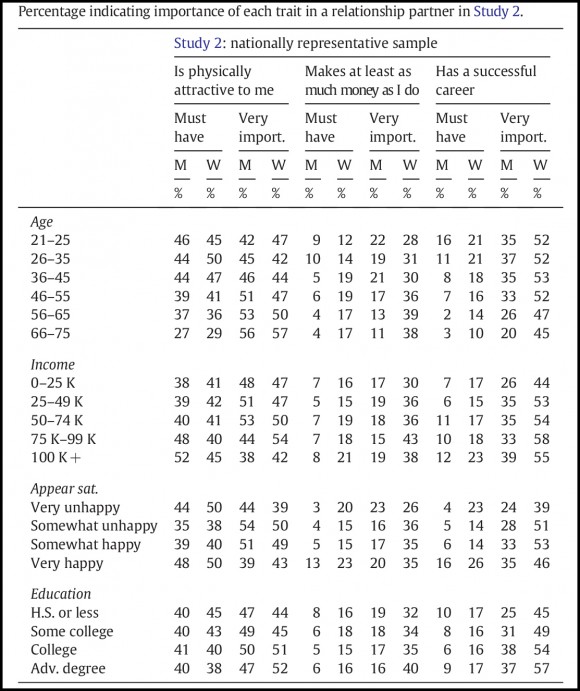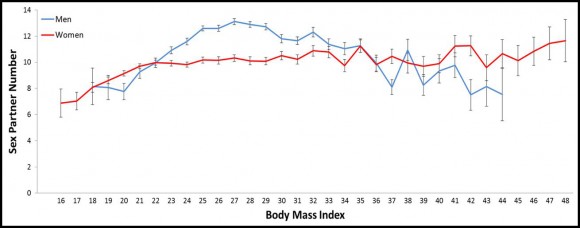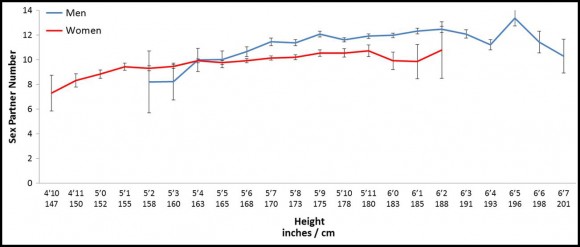New Research Analyzes Height, Weight, Income and More In Regards to Sex and Dating How does your BMI, how tall you are, and your job, influence your attractiveness?
September 29, 2015
The idiom “beauty is in the eye of the beholder” has been used by everyone from Shakespeare to Benjamin Franklin, but what happens if you survey thousands of ‘beholders’ to try and get down to the bottom of what specifically beauty really means? That’s exactly what Crean College of Health and Behavioral Science’s
David Frederick, Ph.D
, did while conducting two separate pieces of recently published research on what people find “desirable” and “essential” in long-term partners
through the lens of the “mating market”
, and how the number of sex partners a person has had
differs according to their gender, height, and body mass
.
The “mating market” is an easy way to process the individual differences and variations between people in regards to mating – more specifically looking at how men and women process and categorize an appropriate mate. In laymen’s terms, this can easily be broken down into two different categories: What qualities YOU prefer, and what qualities OTHERS prefer in YOU.
“We looked at the extent to which attractiveness and resources are ‘desirable’ versus ‘essential’ to men and women when they are looking for a long-term partner,” said Dr. Frederick. “We’ve known for a long time that men care more about attractiveness in a long term partner, and women care more about resources. In two national datasets, we found that gender was by far the strongest predictor of what people want in a long-term mate: it was more important than age, income, education, or confidence in appearance.”
Yet age also played a major factor in the research, which surveyed over 28,000 people. Older people – both men and women – had weaker preferences across the board. As Dr. Frederick points out, it’s more than likely that traits like being attractive and having a great job transition into the idea of companionship the older you get. ”
Appearance and income aren’t going to hold your hand when you are in the hospital or sick or when you are playing board games together at night,” he says. “(Traits shift to things)
such as shared values, financial responsibility, being a wonderful companion, being sweet or thoughtful.”
Logically, younger people are likely just beginning to experience the “mating market” and are less focused on longer term companionship elements; instead they have more intentional, defined and perhaps lofty expectations for their future partner. Men and women, ages 18-25, found qualities like being good looking, having a slender body, and having a successful career to be more essential than any other age bracket. They were also the least interested in qualities like having a steady income, and were generally less interested in qualities like making an equal amount of money, or even making a lot of money.
“One clear message from the research is that people ages 18-25 put substantially more importance on good looks than other age groups, and this is particularly important to young men,” said Dr. Frederick. “As men enter their thirtys, they start to put relatively less importance on appearance (and) consider it less essential. One source of concern women have with their bodies is driven by concerns that men prefer slender women. ”
When asked to give her instant reaction to the research, psychology student Savanah Jewett wasn’t shocked by the essentialness of attractiveness for men. “It does not surprise me that males place a bigger importance on attractiveness than females. I can tell this is true just by talking to my friends,” she said. “My female friends always place an importance on the personality of the guy they are dating, and my male friends tend to talk much more about the attractiveness of the girl they are dating. I feel like guys enjoy bragging about how ‘hot’ their girl is. I always notice guys working hard to get with a girl just because she is attractive, even if they do not know her personality at all.”
From the male perspective, psychology student
Milad Khosravi points out that for a mating market like Chapman University, when everyone is beautiful, suddenly you have to look for other traits and characteristics other than attractiveness. “
With a significantly female-dominant student body and an unashamed reputation for harboring beautiful women, there is certainly no shortage of sexual attraction at Chapman University,” says Milad. “But in light of this, strangely enough, the importance of physicality begins to fall by the wayside. A mating market so highly saturated with good-looking women relative to the population gives men many options, so much so that ideal mate selection becomes much less dependent upon face-value features. I, myself, place a large significance on character attributes, such as humor and ambition, over physical attractiveness.”
“Although physical attraction is important to young men, with 40% of them considering it ‘essential’ that their partner be ‘good-looking,’ only 18% of men ages 18-25 consider it “essential” that their long-term partner is ‘slender’.
We know from other research that
when you ask college
men and women to rate the attractiveness of their partner, they tend to consider their partner more attractive than average, and men in particular rate their partners quite highly,” said Dr. Frederick. “What both men and women agree on is that they want a partner that is attractive to them, and many factors influence attraction. As people fall in love, their perceptions of their partners attractiveness increase. Doing novel or engaging activities together can increase feelings of attraction.”
Falling in love aside, in the realm of the mating market attractiveness tends to relate back to obvious things like height and weight. In a separate study conducted by Dr. Frederick, as well as Brooke Jenkins, also of Chapman University, over 60,000 heterosexual men and women were surveyed and asked to indicate not only their height and weight, but also the number of “sexual partners” they’d had. The median number of sex partners reported for both men and women ages 30 to 44 was eight partners since they have been sexually active. Overall, 58% of men and 56% of women reported having more than five partners, and 29% of men and 23% of women reported having more than 14 partners.
The previous survey, as well as our perception of women in pop culture, tends to reflect the notion that slender women are desired and thusly it would be logical to assume they have had more sexual partners. Yet these kinds of social norms are only true in industrialized countries and even so, the evidence that being skinny leads to more sexual partners doesn’t exist. As you can see in the chart above, Body Mass Index had a much smaller variance for women than it did men, whose numbers grow and then fall off. Per the survey itself, “slender women likely have the greatest bargaining hand in industrialized countries. It is unclear, however, whether having a stronger bargaining hand and greater attractiveness will lead to more or fewer sex partners for women.”
Height similarly plays a varying factor for both genders, but the numbers tend to remain relatively flat across all variants. For men in particular, the static nature of the data is odd, given how much of a premium it seems is placed on taller men. “These findings confirm that height is relevant on the mating market,” said Dr. Frederick. “However, the relatively limited variation in sex partner number for men across much of the height continuum is difficult to explain. Research has repeatedly shown than women prefer men who are relatively taller than they are. It is possible that for most women there is a certain minimal threshold of height, after which they will consider a male as a potential sex partner, and thus men above that height will end up with similar numbers of sex partners.”
Bailey Waln, a psychology student in Crean College, sees the value in research analyzing the types of attributes valuable in the mating market. “In my three years here (at Chapman), I have noticed that the mating market is extremely competitive because guys are typically only interested in a specific type of woman,” she said. “This specific type of woman typically includes a woman who is physically attractive, skinny, social, and easy to hook up with. Guys here at Chapman, in my opinion, create a first impression of a girl strictly by the way she looks and how attractive she is and that determines whether or not he will hook up with her. Guys base the initial start of a relationship solely on level of attractiveness… while looks are typically still important to women, it is not nearly as important as personality or the resources that can be provided for them by the male.”
Both surveys together provide interesting revelations about the mating market as a whole, putting it in the context of both attractiveness and care-taking. You can read both surveys online at the links below.






